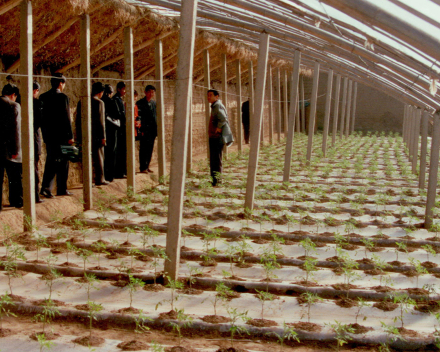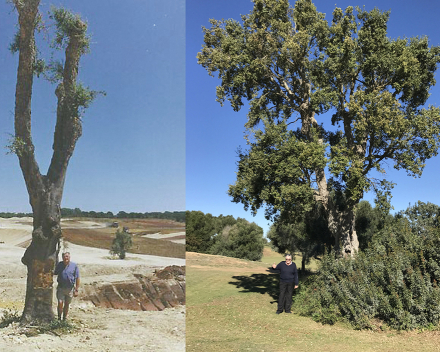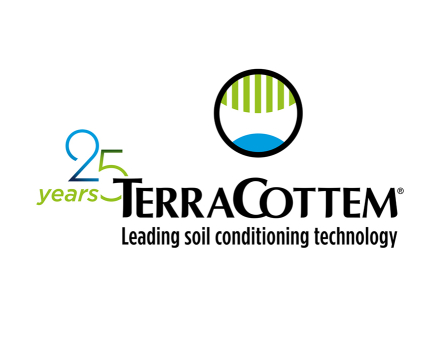- Inicio
- Introduction
Introduction
30/12/2018 - 00:00
TerraCottem founder, Bernard Devos has been the passionate force behind the company over the past 25 years. During that time he has seen many changes and in discussion with daughter Carol who has managed the company for 20 years, he looks at their achievements and what the future holds.
CD. When you first launched TerraCottem as a soil conditioner what did you want to achieve?
BD. Originally I came from the textile industry and when I was approached to buy the TerraCottem licence in 1992, I was drawn by its immense possibilities both from a business and humanitarian point of view. Some 10 years earlier Prof Dr Willem Van Cotthem and a team from the Laboratory of Plant Morphology, Systematics and Ecology at the University of Ghent (Belgium) started a research program to grow plants in the Sahel region of Africa using only the available rainwater. They found that by mixing certain hydroabsorbent, nutritive and root growth stimulating components together, that a superior soil conditioning compound was attained, which produced dramatic and swift results. The result was TerraCottem, the soil conditioner that has been improving growing conditions and plant growth ever since.
In the beginning I tried TerraCottem in my vegetable garden in Spain and was amazed by the results: ‘furious growth’ as our Australian distributors like to say! I have always been a bit of a rebel and enjoy the challenge of going against the grain. TerraCottem was a perfect opportunity to do things differently and better. A good example is our first commercial project: the football pitch in my home town Waregem on a 95 per cent sand root zone layer which was totally unheard of at that time in Belgium! Again we achieved excellent root and grass growth in a very short time. I was immediately convinced. This product had huge potential and I thought it deserved a good marketing strategy and an international distribution network. I had the means to do it and started the business in January 1993.
CD. When you look back at the past 25 years, what are you most proud of?
BD. I think it’s all the barriers we have broken. I knew very little about soils when I was introduced to TerraCottem, but I understood the possibilities it offered. It was the opportunity to grow plants in poor or degraded soils and that its use was not limited to only dry climates. In the early ‘90s soil conditioning was only known to an esoteric public and generally only in countries with an arid climate or for very specific applications such as sports pitches. Water availability and quality were only of concern in certain areas of the world. These days they are hot items. Even in areas with typically frequent and abundant rainfall, precipitations have become more erratic and of concern when planting. We have raised awareness and in many areas educated people. Soil conditioning is a much better established concept nowadays in our professional industry and water savings is on everyone’s agenda. TerraCottem has passed its growing pains. It has entered adulthood.
I am also very proud that the company remains a family business.
CD. Are there some highlights?
BD. On the humanitarian front we have sponsored numerous projects. One in the Gobi desert with ingenuous greenhouses, hospital and school gardens in various African countries, erosion prevention near the San Pedro river in the Navajo Reserve in Tucson, to name a few. Commercially, we have enabled our clients to bring some of their mad planting dreams to fruition: from hanging grass sculptures and trees, to growing a lawn on a beach. There are plenty of examples of less mad projects but challenging ones in this book. We are present in more than 40 countries worldwide and have built a network of very loyal distributors and clients that share our values!
These days we are focussing more than ever on the synergetic effect of all the product’s components, on root and plant growth and the holistic approach to achieve successful planting projects.
CD. Why do you think TerraCottem is so successful and leads the field and has established itself in over 40 countries?
BD. They – that’s Universal, Complement, Turf and Arbor – are still the best performing all-in-one soil conditioners. There are studies abound that prove their superiority compared to other soil conditioners or copies. But TerraCottem goes hand in hand with good horticultural practice, which is supported by our authorised distributors worldwide. Part of the success is also down to the work our distributors do. They are ‘real believers’; some are even obsessed by TerraCottem. It’s almost like a cult, a big family. We are very proud on the relationships we have with our distributors.
CD. 25 years on the world has different challenges - lack of green spaces in heavy populated areas, climate change pressures, lack of water and the need for more sustainable solutions for plant growth. Surely all this means a bright future for soil conditioners?
BD. Yes indeed! TerraCottem addresses some of the world’s biggest issues such as lack of water, hunger and deforestation. With just 20 grammes and a single application in the plant’s lifespan, TerraCottem helps a plant to settle in, grow faster and survive, often in very hard conditions, such as sandy soils, reclaimed land, soil with high salt content, areas with little rainfall or difficult access for watering. TerraCottem is a product for the present day and the future.
CD. And what of that future?
BD. The main challenge is to differentiate ourselves from bad products and copies that appear on the market and that disturb the confidence in soil conditioners. TerraCottem is a complex product and we need to simplify the message. With changing conditions and increased environmental pressures we have to continue to demonstrate its ability, benefits and longevity. It is the cost effective solution and so different from the copies. We want the industry to view TerraCottem as an indispensable tool, in a world where soil and water availability becomes more critical.
Adding grams of TerraCottem to the soil when planting should become an automatic gesture.
CD. The oak tree that is featured on this page above has been transplanted and flourished thanks to TerraCottem, what is the science behind that achievement?
BD. This cork oak tree is 200 years old. It was a very important challenge for me to ensure its survival, as these trees generally don’t survive transplant. There was a lot of expectation surrounding the transplanting of this tree, as I convinced specialists TerraCottem would make a difference and the tree would not only survive but also thrive. I had a picture taken just a couple of months after the transplant and another almost 20 years later. This tree proved many people wrong. The secret of this little miracle is of course the right rate of TerraCottem but there are other very important actions: the swift execution of the transplant to prevent the fine roots from drying out, preferably removing and planting the tree in the same day. The tree’s roots have to be covered to protect them against sunlight. It also needs to be protected from bark damage. I also recommended mixing some soil from the tree’s previous site with the soil at the new destination. And finally irrigate thoroughly after planting. I have since planted over 20,000 trees and shrubs with very high tree survival rates.
| Adjunto | Tamaño |
|---|---|
| 1.71 MB |
Throughout our jubilee year, we will be sharing each one of our 25 client stories with you online.
Dive into historyThroughout our jubilee year, we will be sharing each one of our 25 client stories with you online.
Dive into historyTerraCottem Intl. SL
Apartado de Correos 4511190 Benalup (Cádiz)España



